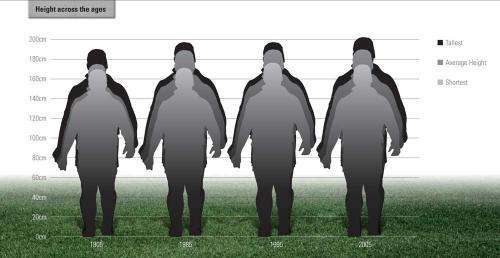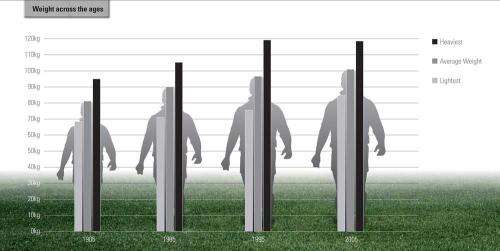Scientists predict All Blacks to grow in strength

The iconic image of Sonny Bill Williams’ muscles bursting out of his jersey is a legacy from a Rugby World Cup where the spotlight has been on physique.
Now Massey University sport scientists have demonstrated visually how the All Blacks are much bigger with more muscle mass than their predecessors.
They have tracked the height and weight of our top players to create a display on behalf of the University entitled The changing physique of the All Blacks, 1905-2005, which is housed in the Rugby Museum in Palmerston North.
The data also shows a recent trend to the build of players becoming more uniform, regardless of their position on the field.
The information, which ranges from 1905 to 2005, was collected by a team from the School of Sport and Exercise led by Associate Professor Steve Stannard and lecturer and former Manawatu rugby player Jeremy Hapeta.
It shows on average, a team member in the All Blacks in 2005 was 187cm tall, or 12cm taller, than the ‘average’ 1905 Originals player. His weight, at 102.5kg, was some 7.5kg greater than the heaviest of the Originals. The lightest player in 2005, at 84kg, was still 3kg heavier than the ‘average’ Original.
Mr Hapeta says while the general population is getting bigger in terms of ‘quantity’ of mass, which is related to the global obesity epidemic, the All Blacks are getting better in terms of ‘quality’ – they are more muscly. While the average height of the 22-man All Blacks semi final squad that beat the Wallabies on Saturday was 187.5cm, their weight was 105kg with another 2.5kg of lean muscle compared to 2005.

The sport scientists estimated body shape through the Body Mass Index (BMI) calculation. Mr Hapeta says in 1905 the difference in BMI between players was small with their physical sizes and shapes all quite similar. “If a player mislaid his jersey, he could probably borrow a near fit from a team member,” he says Mr Hapeta.
In the 1985 ‘pre-pro’ and 1995 ‘semi-pro’ teams, the variance in BMI was more than double that of the Originals, meaning that players were much more varied in shape, probably due to positioning specialisation. However in 2005 the variation in BMI is decreasing again with the build of the players becoming more uniform.
“Traditionally if you were short you were put in the backs and if you had a puku you were put in the forwards but that was the amateur game. Now they want a prototype ‘robo’ rugby player. Guys like Sonny Bill Williams are evening things up again.”
Mr Hapeta attributes the reason for growth to fewer childhood illnesses and better nutrition during the last century, leading to better health and improved physical characteristics for future generations. But he says the professionalism of the game is a key factor in players getting vastly fitter and larger.
“They are paid to train and, perhaps more importantly, paid to rest,” says Mr Hapeta. “Without the competing demands of secondary employment, they train hard and recover well. They bulk up at the gym and the best of sports science and nutritional knowledge is applied to making them bigger, faster and stronger.”
Mr Hapeta says if the emergent trends are anything to go by, we are not yet approaching the limits of the possible.
“We are not going to see the growth spurts at the level we have seen from 1905 to 2005 – 12cm and 7.5kg – we will not see those sorts of leaps but we could see them growing by 1-2cm average height and 2-3kg average weight.”
“You can lay odds that the All Blacks jerseys of the future will come in yet larger sizes,” he says.
Provided by Massey University

















